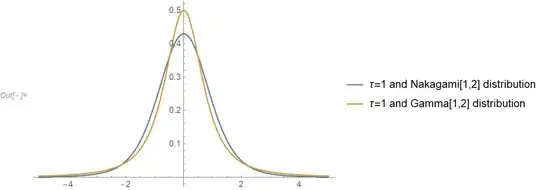I have on one hand a z variable following a standard normal distribution N(0,1) and on the other hand a variable X following a Nakagami distribution. I am supposed to find a Gaussian distribution when I take the product of the two distributions described above. I can't find it as I am left with an expression resembling a gamma distribution inside the integral. Has anyone come across that kind of question? Are there different kinds of Nakagami distributions?
- 95,027
- 13
- 197
- 357
- 21
- 3
-
You won't end up with a normal distribution. But the resulting distribution will look somewhat normal when the Nakagami shape parameter is large (say 20 or larger depending on the eye of the beholder). And I assume you mean the product of two random variables rather than the product of their respective densities. If so, you should modify the title to reflect that. – JimB Apr 30 '20 at 03:57
-
Are the parameters of the Nakagami distribution fixed and given, or do they have to be chosen arbitrarily? – Andreas Steimer Apr 29 '20 at 21:56
-
1I mentioned Nakagami as I have the square root of a gamma random variable. I am not sure how to select the Nakagami parameters – NafNaf Apr 29 '20 at 22:22
-
And so the parameters of the gamma distribution are fixed and given then, or are they supposed to be chosen arbitrarily? – Andreas Steimer Apr 29 '20 at 22:31
-
1Chosen arbitrarily I guess – NafNaf Apr 29 '20 at 22:39
-
@JimB I have the following expression: $Y_{i}=\beta_{o} + \frac{Z_{i}}{\sqrt{\lambda_{i}\tau}}$. I need to find the distribution of Y knowing that Z is normally distributed and $\lambda_{i}$ has a $\gamma$ distribution. I might have solved this problem, I actually found a t-distribution. When calculating the density probability of a ratio, we end up with a product of probability densities when the variables are random and independent. – NafNaf Apr 30 '20 at 11:42
-
1Your title says you're multiplying *distributions*, which I would normally take to mean "multiplying distribution functions" but could perhaps mean "multiplying pdfs". However, reading your body text I wonder if you might actually mean to ask about the distribution when *multiplying the random variables*. Can you make it explicit what is actually being multiplied please? – Glen_b Apr 30 '20 at 12:47
-
2Yes I actually mean multiplying pdfs – NafNaf Apr 30 '20 at 13:15
-
Are you *sure* this is what you need to do? It doesn't make much sense, because whenever two pdfs are multiplied the result is rarely another PDF. – whuber Apr 30 '20 at 14:26
-
Would you edit your question to be consistent with your comments? Do you have a unit normal distribution with a gamma ($\gamma$) distribution or a unit normal with a Nakagami distribution? And what is $\tau$ in your comment? – JimB Apr 30 '20 at 16:31
1 Answers
If $Y=b_0+Z/\sqrt{\lambda \tau}$ where $Z\sim N(0,1)$ and $\lambda$ has either a gamma distribution (with parameters $a$ and $b$) or a Nakagami distribution (with parameters $m$, and $w$), then Mathematica (and not my limited algebraic skills) finds the following pdf's for $\tau>0$ and assuming that $Z$ and $\lambda$ are independent:
d1 = TransformedDistribution[b0 + z/Sqrt[n \[Tau]], {z \[Distributed] NormalDistribution[0, 1],
n \[Distributed] GammaDistribution[a, b]}];
pdf1 = PDF[d1, z]
$$\frac{2^a \sqrt{b} \sqrt{\tau } \Gamma \left(a+\frac{1}{2}\right) \left(b \tau (b_0-z)^2+2\right)^{-a-\frac{1}{2}}}{\sqrt{\pi } \Gamma (a)}$$
d2 = TransformedDistribution[b0 + z/Sqrt[n \[Tau]], {z \[Distributed] NormalDistribution[0, 1],
n \[Distributed] NakagamiDistribution[m, w]}];
pdf2 = PDF[d2, z]
$$\frac{\sqrt{\tau } \sqrt[4]{\frac{w}{m}} \left(2 \Gamma \left(m+\frac{1}{4}\right) \, _1F_1\left(m+\frac{1}{4};\frac{1}{2};\frac{w (b_0-z)^4 \tau ^2}{16 m}\right)-\tau (b_0-z)^2 \sqrt{\frac{w}{m}} \Gamma \left(m+\frac{3}{4}\right) \, _1F_1\left(m+\frac{3}{4};\frac{3}{2};\frac{w (b_0-z)^4 \tau ^2}{16 m}\right)\right)}{2 \sqrt{2 \pi } \Gamma (m)}$$
Maybe you are directly integrating the product of the pdf's of $Z$ and $\lambda$ to obtain the pdf of $Y$ but it's all about how you do the integration which is why I think your title is misleading. I have chosen the lazy way (and most efficient for me).
As an example consider $b_0=0$, $a=1$, $b=2$, $m=1$, $w=2$, and $\tau=1$:
Plot[{pdf1 /. {b0 -> 0, m -> 1, w -> 2, \[Tau] -> 1},
pdf2 /. {b0 -> 0, a -> 1, b -> 2, \[Tau] -> 1}},
{z, -5, 5}, WorkingPrecision -> 30,
PlotLegends -> {"\[Tau]=1 and Nakagami[1,2] distribution",
"\[Tau]=1 and Gamma[1,2] distribution"}]
- 2,043
- 8
- 14
-
yes, I am directly integrating the product of the pdf's of and to obtain the pdf of .Since I can't upvote posts yet, I allow myself to comment a "thank you". – NafNaf Apr 30 '20 at 18:34
-
Thanks for the accept. If you could, adding in the details into you question would be great. My answers were more along the lines of guesses as to what I thought you wanted and this forum is for more of a long term repository of questions and answers. So it would help future inquires when folks search this site. – JimB Apr 30 '20 at 19:41
